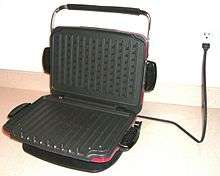Floating hinge
A floating hinge is a hinge that, while able to behave as a normal hinge, enables one of the objects to move away from the other - hence float. In effect the hinge allows for two parallel axes of rotation, one for each object joined by the hinge, and each axis can be moved relative to the position of the other.[1]

Uses

Floating hinges are used in flatbed scanners designed to scan thick objects such as books. A sheet of paper is placed on the glass, and the cover is lowered over it; the glass, the paper, and the sheet are very close together. If a thick book is placed on the glass an ordinary hinge would leave the cover at an angle to the glass. A floating hinge raises the hinged edge of the cover to the level of the book, so that the cover remains parallel to the glass, but raised above it.[2]
Floating hinges are also used in two-plate electric cooking grills, as they allow for even heating of both sides of a thick piece of food without crushing it.[3]
See also
- Concealed hinge jig – Support and locating tool for drilling recess holes to mount concealed hinges
- Hinge – Mechanical bearing that connects two solid objects, typically allowing only a limited angle of rotation between them
- IKEA – Trademark used for retail of furniture, appliances, and home furnishings that you can build
References
- mrhardwareco.comm (May 2014). floating-hinges. mrhardwareco.com.
- John Dawson (1988). Prints and Printmaking. New Burlington Books. ISBN 978-1-85348-110-9.
- yourultimatekitchen.com (May 2014). floating-hinge. yourultimatekitchen.com.
External links
| Look up hinge in Wiktionary, the free dictionary. |
| Wikimedia Commons has media related to Hinge. |